Perspectives
The Deloitte Research Monthly Outlook and Perspectives
Issue 88
Tentative recovery amid stock market jitters
Published date: 19 February 2024
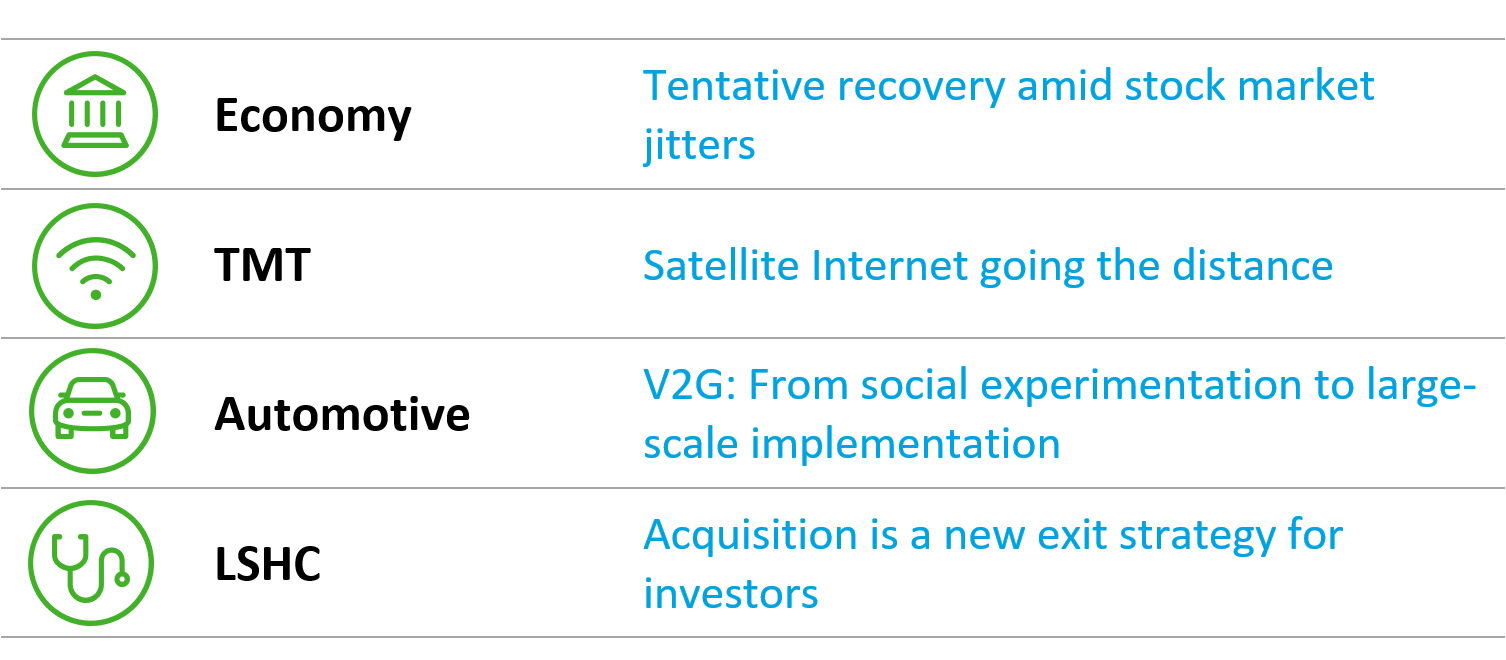
Economy
Tentative recovery amid stock market jitters
Should China unveil a large fiscal stimulus? This question has lingered for nearly a year and refuses to fade away. The ongoing volatility of the stock market has thrust this question to the forefront because investors seek more policy support for an economy with uneven recovery - a stable consumption (rising 7.2% in 2023) but sluggish investment (growing at 3.0% in 2023), primarily due to property woes (contracting by -9.6% in 2023). Additionally, investors desire a credible policy signal that economic growth remains a paramount goal amid geopolitical tensions.
With the domestic stock market persistently selling off due to a range of factors, which we could elaborate on, proposals for creating a stock market stabilization fund have been speculated by various analysts and policy wonks (as reported by Bloomberg). As of the week before the Chinese New Year, the market has declined by nearly 10% this year as of early February. Meanwhile, 10-year bonds issued by the Ministry of Finance have fallen to 2.4%, the lowest in the past 20 years, highlighting an increasing risk of deflation.
Chart: Plummeted 10-yr bonds yield highlights a deflation risk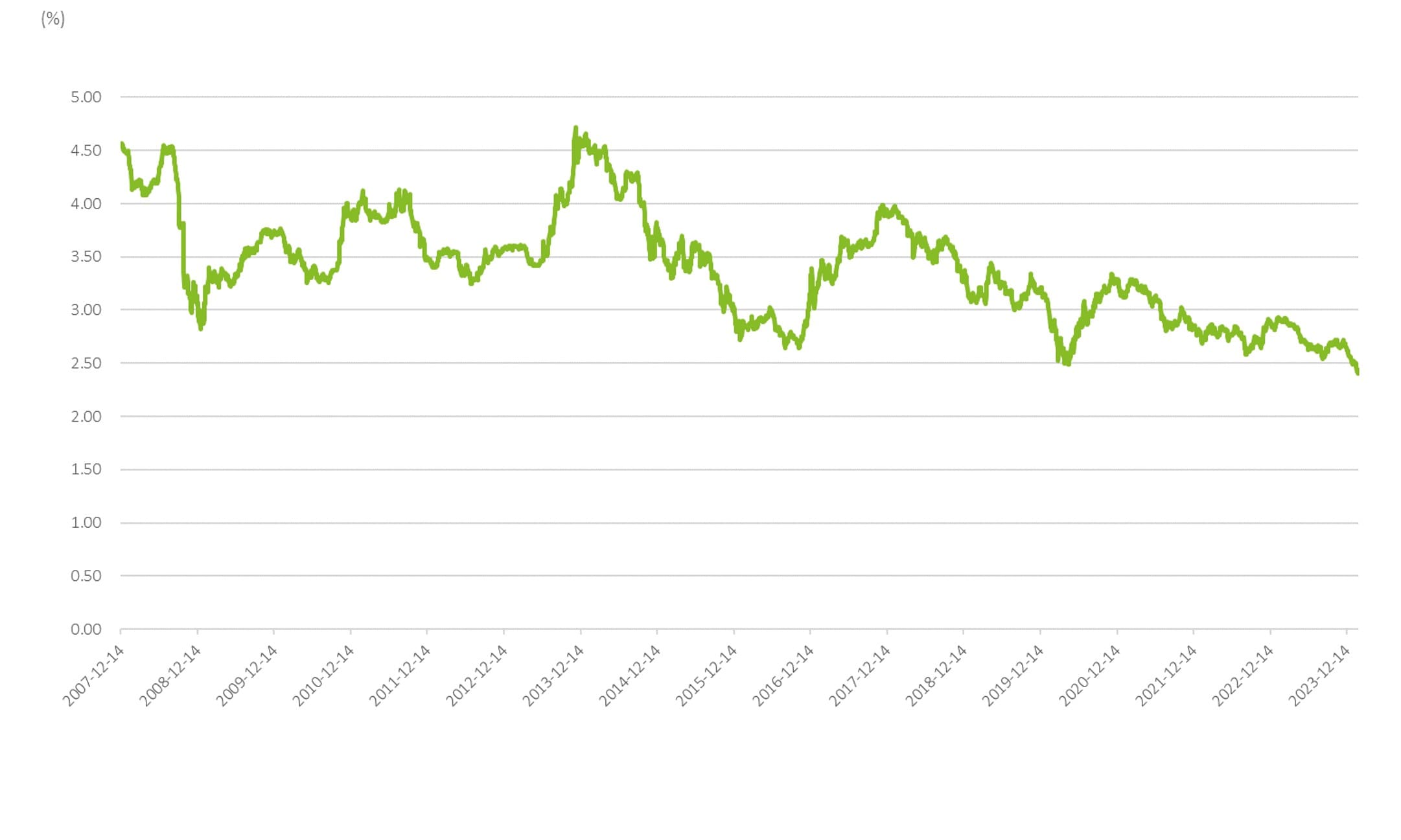 Source: Wind
Source: Wind
Investors' expectations of a substantial stabilization fund have not materialized, but the relatively stable performance of large caps, such as banks and energy companies, suggests that state pension funds have consistently supported the market, given their disproportionally large weight in the index. The saving grace is the stock market which has being dominated by retail investors (over 99%) is less related to the real economy over years.
Apart from investors' disappointment with inadequate liquidity injections (e.g., interest rate cuts), lingering concerns over the property sector remain a significant overhang on the stock market. Certain large gyrations in the volatile A-share market this year were caused by forced redemptions of wealth management products linked to real estate. Due to the intertwined relationship between property prices and the stock market, stabilizing the property market remains a policy priority, in our view. Except for Beijing, other first-tier cities (Shanghai, Shenzhen, and Guangzhou) have relaxed restrictive policies on demand (e.g., local residence requirements and certain number of years of social security contributions). We have been advocating policy initiatives to remove distortions in housing, but market psychology is also like a moving goal post. Therefore, given that sluggish housing activities have impacted the stock market, more potent policy responses, beyond eased restrictions, would be warranted. For example, eased restrictions on housing demand could be extended to more central areas in Beijing and Shanghai. Mortgage rates could be reduced, and the initial down payment for second homes could be significantly lowered.
Revisiting the option of a fiscal stimulus, replicating what China did in late 2008 is not feasible. The current need to unwind leverages from firms and local governments, coupled with overcapacity in various sectors, makes involution a national concern. Elevating the role of personal consumption, or at least preventing precautionary saving rate from rising, is crucial. Despite challenges in the property sector, overall economic growth remains resilient (PMI in January has risen to 49.2%). While sympathizing with policymakers' commitment to fiscal discipline, lessons from the US's economic resilience during the Covid era suggest a calibrated fiscal support to low-income households and SMEs could be beneficial. Fiscal transfers to local governments, impacted by weak property sales, are necessary, but a cautious approach is required to avoid excessive spending. Growth must rely on consumption, private investment, and exports. The property sector is expected to undergo a prolonged consolidation period, possibly posting a 4-5% contraction in 2024 GDP growth. Concerns about asset deflation causing a spiral are deemed unlikely, given China's low consumer leverage and a different financing landscape compared to Japan. Revitalizing confidence hinges on concrete actions signaling economic development as a policy priority, rather than extensive pump priming. Learning from Japan, China should avoid creating public works with no returns. Even if the US economy strengthens, the PBOC could forcefully slash interest rates, contrasting potential Fed policies.
TMT
Satellite Internet goes the distance
Low earth orbit satellite has become the focus of the global aerospace industry in recent years. As of December 2023, more than 4,000 satellites had been launched under the SpaceX - Starlink program, covering most parts of the world. By 2023, China's satellite internet market surpassed RMB 30 billion, and is expected to increase to RMB 44.7 billion by 2025. With a strong government push to develop the satellite internet industry, China has already launched over 600 application satellites, second only to the US. Strong policy support has made it possible for satellite internet technology to be constant upgraded and industry standards are getting ever more refined in China. In the 15th Five-Year Plan period, China’s satellite internet industry is expected to achieve decade-long growth.
Chinese enterprises are well-positioned in key areas along the satellite internet value chain. In future though, Chinese satellite companies will need to further strengthen their technological capabilities, develop low-cost and high-quality satellites, and accelerate the process of low earth orbit satellite networking. We believe the following five trends will shape the future of China’s satellite internet in the coming years:
1. Cost optimization will play a key role in scaling of the industry. With regard to rocket manufacturing and launching, companies will focus on rocket recovery technology and a "one rocket-multiple satellites" approach. On the one hand, resources can be recycled to improve the reuse rate of rockets while reducing costs. This can help improve the utilization of rockets. On the other hand, the carrying capacity of the rocket can be fully utilized by launching multiple satellites into designated orbits with a single rocket either at the same time or sequentially, thus reducing launch costs. While in the manufacturing stage, miniaturization is driving the commercialization of satellite internet, such as in communication, meteorology, remote sensing, and navigation. Finally, in the operation stage, promoting industrial scaling and deployment will help cost reduction via increased efficiency and effectiveness.
2. Low earth orbit satellite launches to show rapid growth. Technological progress in China's satellite manufacturing and rocket launches has benefitted to construction of low earth orbit satellite constellations. In China, satellite constellation plans such as "Hongyan", "Hongyun", and "G60" have been proposed. These aim to launch multiple low earth orbit communication satellites to form satellite internet networks. Major domestic low earth orbit satellite internet systems include "GW constellation" and "G60 Starlink". These have a total planned capacity of about 25,000 low earth orbit satellites. The two constellations will be the core carriers of future domestic low earth orbit satellite internet networks. With the accelerated deployment of the two major plans, 2024 will become the first year of intensive launches of low earth orbit satellites in China. As the technology and market matures, we will certainly see an increase in domestic low orbit communication satellite launches in 2026.
3. The BeiDou system will complement low earth orbit satellites to form complete coverage. BeiDou communication satellites have been continuously improving their reliability and service performance. The low earth orbit satellites are scheduled to be incorporated into the new generation BeiDou system and high, medium, and low orbit constellations shall be integrated. These will resolve the performance choke point of PNT services and provide a high-precision global spatiotemporal network that provides full coverage and high-reliability navigation, positioning, and timing services from indoor to outdoor, and from deep sea to deep space. This will enable the safe operation of major national infrastructure such as transportation, finance, power, and communications.
4. Satellite mobile phones will make possible the mass adoption of applications. Direct links between satellites and mobile phones has gradually become the major development direction of satellite internet applications. Currently, base stations are still the key measures for 5G network coverage, and there exist many communication blind spots such as deserts, uninhabited areas, and oceans that are not covered by base stations. Therefore, achieving signal transmission and reception between ordinary smartphones and satellites will open up the mass market for satellite internet applications. Currently, major domestic smartphone manufacturers are accelerating the research and development of direct satellite connection technology. As technologies (such as direct satellite connection and communication terminals) develop, 2C satellite communication applications, including remote areas, aviation, maritime operations, scientific expeditions, are also gradually maturing.
5. Private investment continues to contribute to the construction and merging development with SOEs. Currently, investment in the satellite internet industry is still at an early stage. In the field of satellite manufacturing, State-owned enterprises (SOEs) are in the lead as they are able to leverage their R&D advantage and coordinate the construction of satellite networks, while private enterprises mainly focus on component manufacturing and ground equipment.
Currently, various entities such as State-owned enterprises and private companies are actively promoting the development of the satellite internet industry and have developed an effective footprint in areas such as satellite manufacturing, satellite launches, ground equipment manufacturing, and operational services. In the future, companies will continue to leverage in-house advantages to promote the development and construction of satellite internet. Companies with existing constellation plans can make the achievement of their deployment goals a target. As for the ground equipment manufacturers, they can accelerate the exploration of auxiliary services for satellite launches. However, it should be noted that China's satellite internet construction, especially low earth orbit satellite internet construction, is still in its early stages, and there are roadblocks; for example, the high cost of satellite manufacturing and launches. At the same time, national policies continue to broaden the channels and scope for private enterprise to participate in the satellite internet industry, intensifying competition.
Automotive
V2G: From social experimentation to large-scale implementation
The technology that enables intelligent interaction between electric vehicles and power grid, known as Vehicle-to-Grid (V2G), is transitioning from social experimentation to large-scale application. On January 4, 2023, the National Development and Reform Commission (NDRC) along with three other departments ministries announced their “implementation opinions on enhancing the integration and interaction of new energy vehicles with the power grid”. The draft opinion provides policy guidance in four main areas, including promoting core technology development, establishing a standard system, improving perfecting electricity pricing and market mechanisms, and encouraging exploring bidirectional charging and discharging demonstration projects across the country, helping lay a policy foundation for large-scale application of V2G interaction.
What are the prospects for the development of V2G interaction? What barriers need to be removed for its widespread adoption? How can companies up and down the automotive industry chain tap into this emerging market?
V2G refers to the bidirectional transfer of energy and information between electric vehicles and the power grid. For a long time, electric vehicles have been consumers of electricity. But now, through technological transformation and the establishment of a feasible economic mechanism, they can function as distributed energy storage units, participating in the grid's intelligent dispatch, engaging in demand response markets, ancillary markets such as frequency regulation, peak shaving, standby power, and electricity spot trading, thereby giving additional economic benefits to their owners.
Graph: Commercialisation scenarios of V2G in different charging situations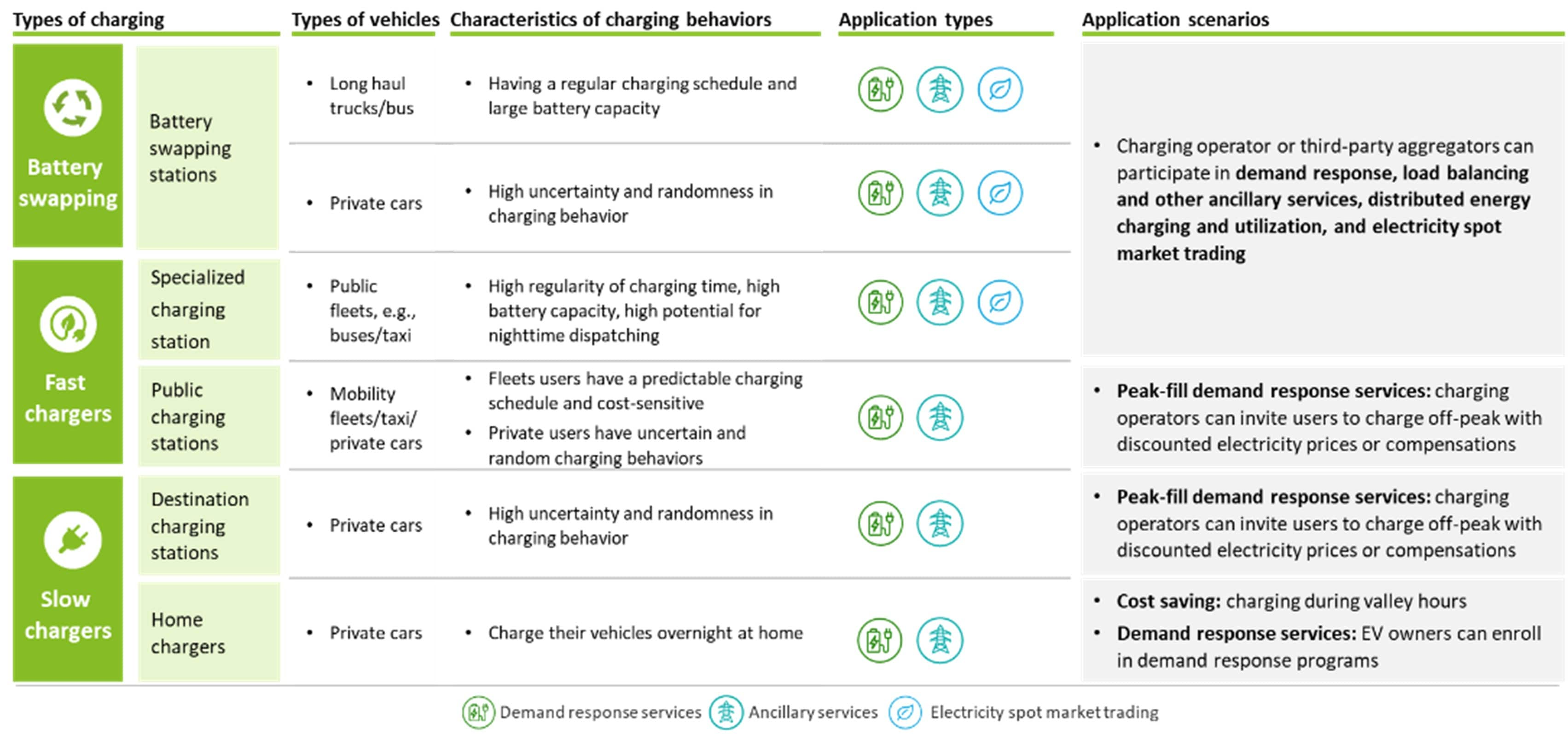 Source: Whitepaper of scaled application and development of V2G
Source: Whitepaper of scaled application and development of V2G
For example, in regions with significant differences in peak and off-peak electricity prices, electric vehicle owners can sell electricity to the grid during peak hours and charge their vehicles during off-peak hours to profit from the price difference. Large-scale charging and swapping station operators that manage the charging activities of a certain number of EVs can participate in peak shaving and filling during periods of high demand, such as guiding electric vehicles to charge in an orderly manner at night, absorbing clean power that is generated by wind and hydroelectric power during the night, and playing a role in supporting the grid.
Currently, V2G has become a mainstream trend globally, and overseas automakers have been proactively promoting this technology. In the Chinese market, NIO, Geely, and Great Wall Motors are making steps to adopt V2G technology. Among them, NIO is the frontrunner in developing and implementing V2G capabilities. In January 2024, NIO deployed 10 V2G charging stations in Shanghai, carrying out orderly charging and discharging trials in areas such as industrial parks, office buildings, and residential areas. The EV company also announced a cooperation with energy storage battery company Longi Green Energy to build integrated solar energy storage and charging stations, promoting the use of both photovoltaic power generation and green clean energy in V2G interaction.
Table: Use cases of V2G technology implemented by auto OEMs in different regions (illustration only)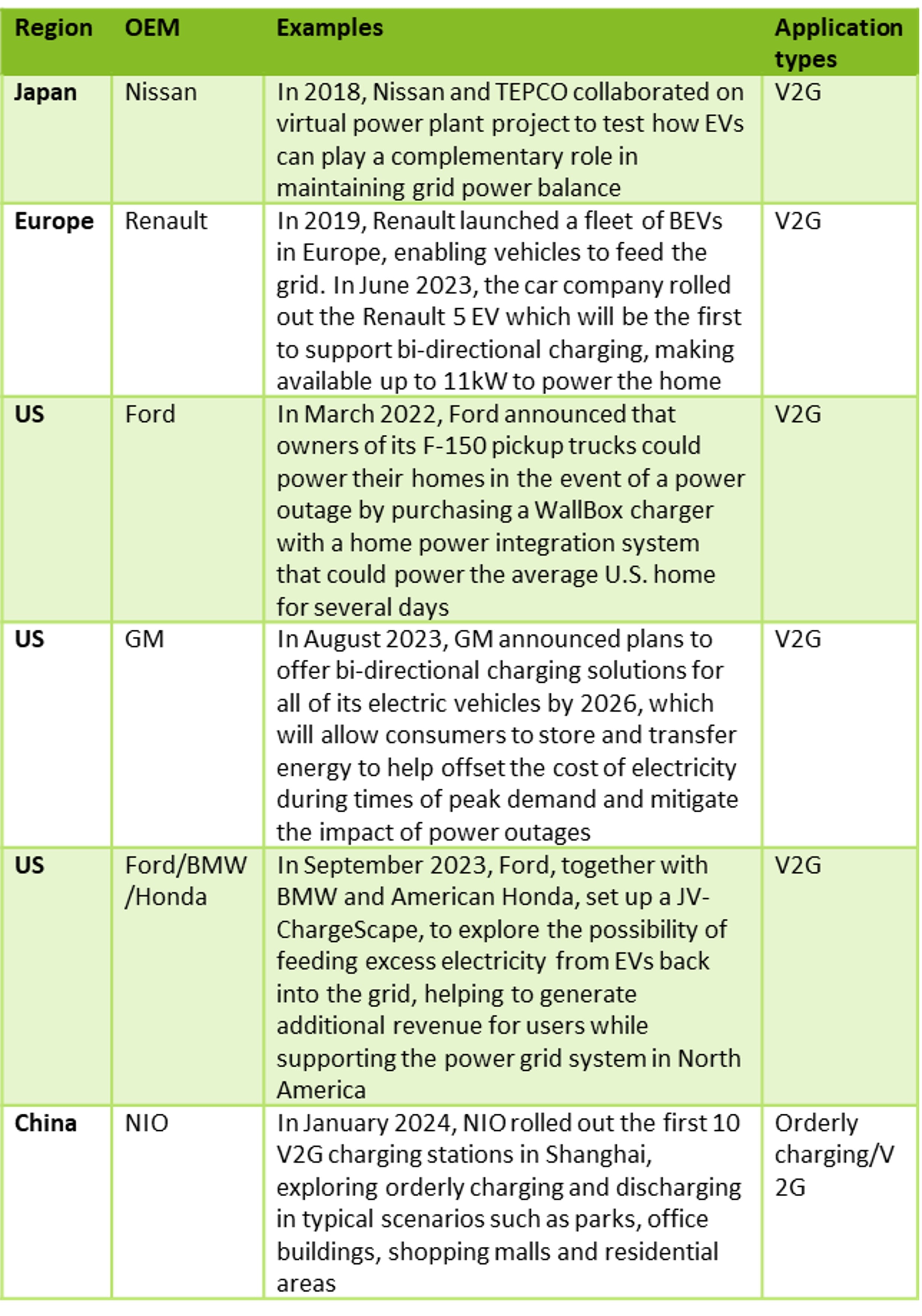 Source: Public information
Source: Public information
However, the transition of V2G from a technical experiment to a profitable business still requires overcoming challenges in multiple areas, including technology, economics, user acceptance, and standard protocols, among others.
First, from a technology perspective, V2G is a systematic engineering project, and its large-scale application requires costly technical upgrades in vehicles, charging stations, and the power grid. For example, achieving bidirectional interaction of electric vehicles involves high-cost hardware and software modifications. Vehicles must support the installation of inverters that convert direct current to alternating current. This would enable electric vehicles to send electricity back to the grid. Also, charging stations would need to add power modules for bidirectional charging and discharging, electricity metering devices, and control circuits to interact with electric vehicles.
In addition, intelligent information and scheduling platforms are needed for vehicles, charging station operators, third-party load aggregators, and power grid operators. This allows the sharing of data, enabling grid enterprises to grasp the spatial distribution of electric vehicles and to control the charging and discharging process of each vehicle through tailored management strategies. Third-party aggregators can provide EV owners with the best charging and discharging strategies based on advanced algorithms.
From an economic perspective, users lack economic incentives to participate in V2G interaction. Charging facility operators lack incentives to upgrade current equipment and infrastructure needed for V2G interaction. Moreover, participation in auxiliary service markets faces access barriers, and the income from auxiliary services relies mainly on government subsidies, lacking market-based incentives. In addition, the immaturity of China’s electricity spot market determines that the price difference between peak and off-peak hours in most regions is not attractive enough to motivate vehicle owners to participate in the reverse discharge operation.
In terms of user acceptance, participating in V2G may lead to a degradation in battery capacity, affecting the vehicle's driving range. This issue has not yet been explicitly addressed in the battery warranty contract, thereby impacting battery warranty service.
Despite the many limitations, prospects for the development of V2G are promising. As V2G is an ecosystem project, it requires cooperation among multiple entities such as auto OEMs, battery manufacturers, charging facilities and operators, third-party load aggregators, and utility enterprises to form an industry collaboration ecosystem. This promotes finding solutions to key technologies on the one hand while it helps to share the initial investment costs on the other. Battery manufacturers can explore solutions to increase the life cycle of batteries without significantly increasing costs and optimize battery management systems (BMS), thus mitigating the impact of high-frequent charging and discharging on battery capacity. Vehicle manufacturers can launch more electric vehicles with bidirectional capabilities and co-operate with charging operators and third-party aggregators to test the economic potential and investment return cycles of bi-directional charging in different application scenarios. With improvement and further marketization of electricity market price mechanisms, commercialization of V2G interaction could become a reality.
Life Science & Healthcare
Acquisition is a new exit strategy for investors
Starting in the second half of 2021, China’s biopharma stock index began to decline as biotech valuations entered a period of correction. Downward trend gradually slowed down in the second half of 2023. Concurrently in 2023, several drugs received global recognition and the number of innovative drugs coming out of China continues to increase. As a result, the numbers of both strategic partnership and out-licensing deals have also increased. Multinational pharma companies (MNC) are actively seeking biotech assets in China or acquiring innovative local biotech companies to expand their business footprints.
In 2024 we expect to see MNCs strengthen their relationships with Chinese pharma companies in order to increase their global competitiveness. Domestically, M&A deals have become the new capital exit channel as regulations have tightened for the IPO route. Innovative Chinese pharma companies will be able to accelerate the pace of their global expansion and integrate into the global pharma landscape more comprehensively.
China pharma’s R&D strength hits a new highThe stream of new drugs coming out of China in recent years has made China’s biotech industry gain recognition internationally, resulting in an accelerated pace of “go global”. The trend is reflected in the following aspects:
- Out licencing deals hit a five year high in 2023: a total of 61 out licensing deals were inked in 2023, 21 more than in 2022. This reflects the increased recognition of Chinese R&D strength by overseas pharma companies. Many of these out-licensing products are FIC/BIC assets, covering various novel segments such as ADCs, bispecific antibodies, cell therapies and the like.
Number of out-licensing assets by type in 2023 Source: Public info, Deloitte Research
Source: Public info, Deloitte Research
- A total of 5 domestically produced new drugs have been approved by the US FDA for marketing since 2019. The sales and revenue of these products have continued to increase in the US market, showing that their efficacy and safety have been recognized by the market. For example, BeiGene’s BTK inhibitor Zanubrutinib’s US sales exceeded USD 360 million in the first half of 2023 while Legend Biotech’s Carvykti made USD 210 million in the first three quarters of 2023, surpassing what they made in 2022.
- Several novel biotechnology platforms established by Chinese biotech have made strategic partnerships with overseas pharma companies. In the past three years, a total of 14 biotechnology R&D platforms, including Biocytogen’s RenMice and HiTS Platform, Harbour Biomed’s Harbour Mice platform, DAC Biotechnology’s ADC platform, have entered into strategic partnerships with oversea pharma companies. These platforms cover a wide range of biotechnologies including cell therapy, protein degradation, ADC, gene therapy, etc.
Cross border M&A may become the next major exit channel for investors
In the second half of 2023, the valuation adjustment process for biotech companies in China was completed. At the same time, MNCs are speeding up their merger and acquisitions activities worldwide. According to Pharmacube, a total of 467 fundraising deals of innovative drugs occurred in 2023, with an YoY decrease of 17.3%, showing an overall downward trend. However, there are signs of recovery at the end of 2023, with an YoY increase of 35.9% in December which mainly resulted from the gradual completion of the valuation correction of Chinese biotech.
In line with our 2023 summary and forecast, China’s local biotech start-ups and investors are looking for new ways to go global through equity acquisitions and M&A deals. In the early days of 2024, there have been two acquisitions of domestic pharma companies by MNCs and a number of high-value out-licensing deals.
- In December 2023, AstraZeneca announced the acquisition of Gracell Biotech, a Chinese biotech, for approximately USD 1.2 billion. The acquisition is to accelerate the deployment of cell therapy and has made Gracell the first Chinese innovative pharma company to be acquired by MNCs.
- In January 2024, Novartis announced the acquisition of SanReno Therapeutics to expand its pipeline in the nephrology field.
- In January 2024, Novartis entered into two exclusive licensing collaborations with Argo Biopharma for RNAi therapy development, with an upfront payment of USD 190 million and a potential total transaction value of USD 4.2 billion.
In 2023, many MNCs have continuously increased their investment in M&A activities, acquiring many at a premium in their rush to secure their global position. According to Pharmacube, there have been a total of 25 acquisitions of innovative pharma companies globally, of which 19 are premium acquisitions. The acquisition of Gracell Biotech by AstraZeneca is ranked 9th in terms of premium rate. MNCs seem determined to use M&As to accelerate the reshaping of their current pipelines in order to face deal with the current economic situation as well as pursuing new growth in the potential areas through the reshaping of their pipeline.
Top 10 Global Innovative Pharma Company Acquisition by premium rate in 2023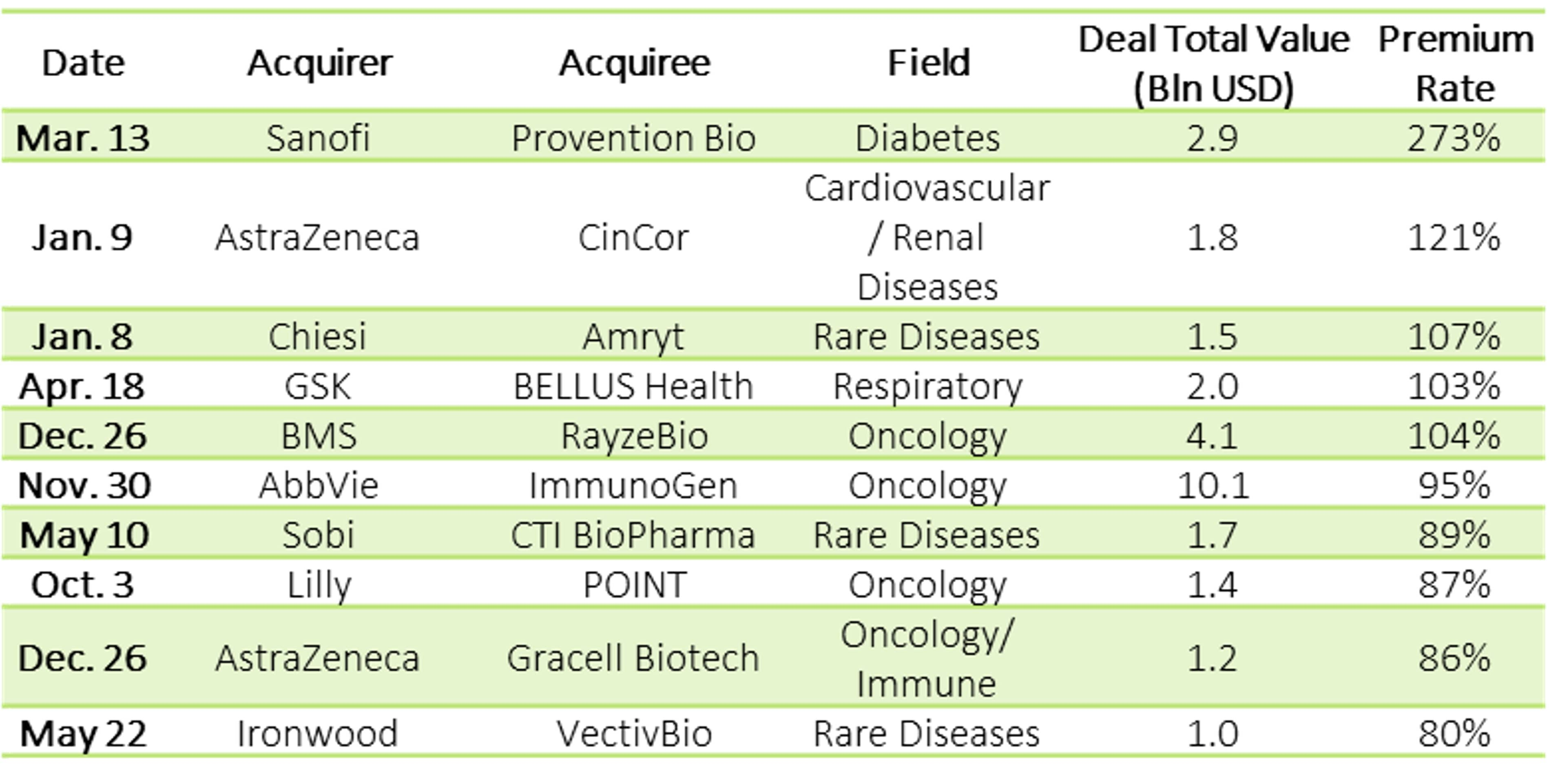 Source: Pharmacube, Deloitte Research
Source: Pharmacube, Deloitte Research
China’s biotech firms are seeking new opportunities in overseas markets
China’s biotech firms, whether in the R&D pipeline or technology platforms, have already become an important investment option for MNCs. As capital cooling continues and domestic IPOs remain tight, M&As may become a new exit channel for investors and for Chinese pharma companies seeking to go global. At the same time, many MNCs are actively optimizing their pipeline, reallocating resources and developing new fields. Therefore, we expect to see many more domestic and overseas M&A deals, further deepening Chinese pharma penetration into the global economic landscape.

